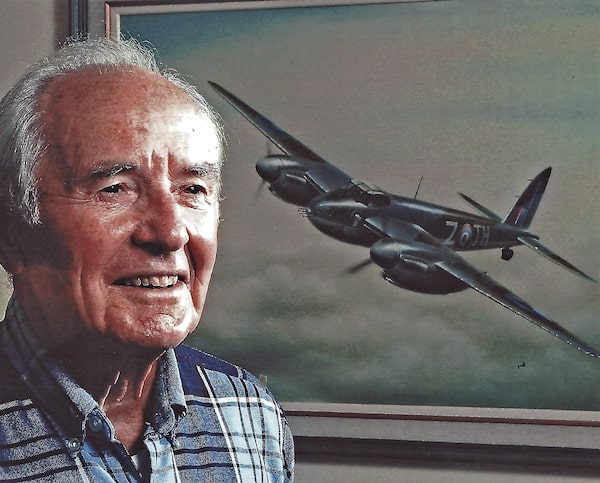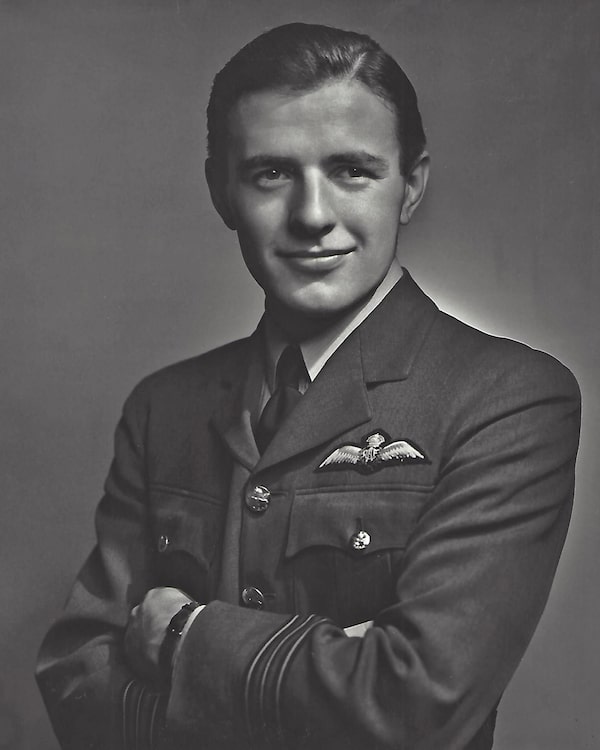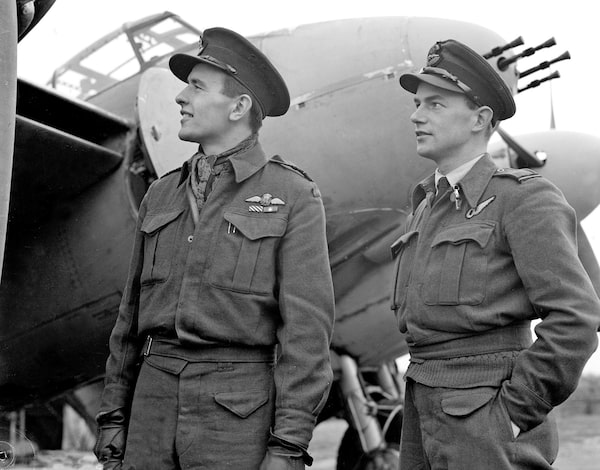
Russ Bannock with a painting of a de Havilland Mosquito. This is the type of plane he flew during the war.Courtesy of the Family
In 1939 when young Russell Bannock was leaving home to become a pilot in the Royal Canadian Air Force, his mother really did tell him “don’t fly too high or too fast.” Mr. Bannock mostly ignored that advice and within a few years became one of Canada’s greatest Second World War air aces. He died on Jan. 4 in Toronto after a brief illness. He had celebrated his 100th birthday in November.
Wing Cdr. Bannock was not the classic lone-wolf pilot. Rather, he flew the superb de Havilland Mosquito fighter-bomber with a navigator and gained renown for the hair-raising job of destroying V-1 pilotless rockets during the 1944 bombardment of London. At that time, hundreds of V-1s were launched from France and Holland toward southern England. The V-1, also called a “buzzbomb” was a forerunner of today’s cruise missile. Wing Cdr. Bannock’s final tally was 19 V-1s and 11 aircraft destroyed. In addition, he destroyed or damaged 15 train locomotives and vehicles.
Some sources have referred to Wing Cdr. Bannock as Canada’s second-highest-scoring ace of the war after legendary Spitfire pilot George (Buzz) Beurling. However, Mr. Bannock himself said most of his attacks were at night so a better description would be “Canada’s leading night-fighter ace.”
Whatever the description, former chief of the defence staff general Paul Manson called him “one of the best of the best.” During the war, both the Lord Mayor of London and British newspapers called him “the Savior of London” for his great success in attacks against Nazi rockets.
In person, Mr. Bannock conveyed the quiet authority of a natural leader. He had been tested by adversity and peril in the war but, in later life, he did not dwell on it. A man of vast talent, he could have risen to the top in the air force if he had chosen to do so. Instead, he was hugely successful in civilian aviation, a field he loved his entire life.
Russell William Bannock was born in Edmonton on Nov. 1, 1919. His family were Austrian immigrants who originally spelled their name Bahnuk but later changed it to Bannock. Young Russell loved airplanes and always wanted to be a pilot. Similar to many wartime aces, he became a crack rifle shot in his teen years.
His first airplane flight was memorable. In 1937, he worked in northern mining camps and was set to fly as a passenger in a small plane from Fort Smith, in the Northwest Territories, to Yellowknife. All the passenger seats had been removed to make room for a load of mattresses and other gear. Mr. Bannock watched, dismayed, as the mattresses entirely filled the passenger cabin. He said to the pilot, “I thought I was going on this airplane. He said, ‘You are, get in there on top.’” Mr. Bannock made his first flight lying on top of the mattresses – no seat belt, not even a seat.

Wing Cdr. Russell Bannock in 1943 in a photograph taken by Yousuf Karsh, the photographer who took Churchill’s famous picture.Courtesy of the Estate of Yousuf Karsh
In his final two years at high school and afterward, Mr. Bannock used the money he saved from working in the north for flying lessons. By mid-1939, still only 19 years old, he earned a commercial pilot’s licence.
When war was declared, many commercial pilots including Mr. Bannock were invited to join the Royal Canadian Air Force. He enlisted immediately and was posted to Vancouver to learn instrument-flying and aerobatics. He recalled wearing a leather helmet and goggles while flying the Gypsy Moth, an open-cockpit biplane.
Mr. Bannock was awarded his air force wings in February, 1940. He flew many types of aircraft in the early war years including the legendary Harvard trainer. He later said, “If you could fly the Harvard, you could almost fly anything.”
What followed was an agonizing turn of events for a young officer eager to see action. Typical of many early RCAF pilots, he spent most of the next four years as a flight instructor in the massive British Commonwealth Air Training Plan. By 1943, he was chief instructor at No. 3 Central Flying School in Arnprior, Ont. It was not until early 1944 that then-Squadron Leader Bannock was able to wangle a posting to Britain.
Just before going overseas, he was matched up with his British navigator, Robert R. Bruce. Mr. Bruce was a remarkable figure in his own right, a grandson of the eighth Lord Elgin, a former governor-general of Canada. After the war, Mr. Bruce became a noted classical-music composer and university professor in Wales. His Symphony in B flat was dedicated to Mr. Bannock and was inspired in part by the night operations they flew together. Mr. Bruce died in 2012 at the age of 96.
When the V-1 rocket campaign began, the two officers were members of No. 418 (City of Edmonton) Squadron, which was assigned to intercept them. The young pair downed their first V-1 on the night of June 19-20, 1944, and as their toll of V-1s mounted, both were awarded the Distinguished Flying Cross.
In an interview some months ago, Mr. Bannock said V-1s were mostly launched in volleys at night and Mosquitos worked in relays to shoot them down. A vivid flash would mark the rocket’s launch while it could then be followed by its exhaust flame.
The V-1 had to be approached very carefully, Mr. Bannock explained, because each V-1 carried a ton of high explosive, and debris from an exploding rocket could bring down the attacking aircraft. In a testament to his deft piloting and exceptional marksmanship, on July 6, 1944, he shot down four V-1s in a single night.
While Mr. Bannock gained fame for attacking V-1 rockets, he had a second and equally nerve-wracking specialty – what were called “intruder” missions. Some of these involved circling German airfields at night to shoot down Nazi night fighters as they landed or took off. Typically, German ground controllers would turn on the runway lights for a few moments just before either operation.
Their first intruder attack was almost their last. On the night of June 14-15, 1944, the two attacked a Messerschmitt 110 fighter as it landed south of Paris when they, themselves, were ambushed. No sooner had the Mosquito pilot opened fire than searchlights flashed on and a curtain of anti-aircraft fire erupted from the ground.
Squadron Leader Bannock was able to shoot down the landing plane but had to take frantic evasive action to escape, commenting later, “I shook all the way home.” By August, 1944, Squadron Leader Bannock had completed his tour of 35 missions and would normally have been rotated out of operational flights but instead he received permission for a second tour.

Wing Cdr. Bannock and his navigator, Robert Bruce of Gloucestershire, England, as they look at the starboard engine of their Mosquito aircraft that brought them back to their station after their port engine was knocked out by flak.Pte Laplante/Courtesy of RCAF
Another close call came only a few weeks later when the two airmen targeted an operational training base on the Baltic Sea. They arrived at dawn to see at least eight training aircraft in the air. Squadron Leader Bannock shot down two aircraft before being targeted by a nearby German fighter. The Mosquito sustained two gaping holes in one wing and the left engine was knocked out. There was a long, slow and anxious flight home on one engine.
In October, 1944, still only 24, Mr. Bannock was promoted Wing Commander and appointed commanding officer of No. 418 Squadron. He recalled that his appointment at that age was not entirely unusual while anyone over 27 was universally known as “Pappy.” Wing Commander Bannock flew missions for the remainder of the war with navigator Clarence (Kirk) Kirkpatrick from Kindersley, Sask.
Wing Cdr. Bannock was subsequently awarded a Bar to his Distinguished Flying Cross and on Aug. 17, 1945, the Distinguished Service Order. The citation noted both his extraordinary flying achievements and outstanding leadership as commanding officer of both No. 418 Squadron and later No. 406 Squadron.
Wing Cdr. Bannock was still only 26 at the end of the war and might have had a spectacular career in the air force. But in 1946, famed aviation pioneer Sir Geoffrey de Havilland offered him a job as chief test pilot at his company’s Canadian operations.
Mr. Bannock then joined de Havilland of Canada and in 1947 piloted the de Havilland Beaver bush plane on its maiden flight. The aircraft went on to become likely the most successful plane in Canadian aviation history, with the United States Army eventually ordering 1,200 of them. Later, Mr. Bannock took time out to run his own company but in 1975 returned to de Havilland, becoming president and chief operating officer shortly after. He retired from de Havilland in 1978 but continued to operate Bannock Aerospace, an aircraft leasing and brokerage company, well into his 70s.
Mr. Bannock was a member of many industry organizations including the Canadian Exporters Association and the Canadian Aerospace Industries Association. For many years he was an active member of the Canadian Fighter Pilots Association, the Aircrew Association and Branch 165 of the Royal Canadian Legion.
Mr. Bannock was named to Canada’s Aviation Hall of Fame in 1983. The citation read: “His inspiring leadership as an instructor and fighter pilot in World War Two, his unusual skills as a test pilot and his corporate business leadership have all been of outstanding benefit to Canadian aviation.” He was later president of the Hall of Fame. He was appointed to the Order of Ontario, two other provincial orders and was awarded France’s Legion of Honour.
Mr. Bannock’s son, Michael, said he was a “private person but a terrific dad and guiding light.”
The elder Mr. Bannock continued to own and fly a Beaver aircraft into his early 90s. Even at the age of 97 he was enjoying flights in a turbo-powered Beaver owned by his son. Mr. Bannock enjoyed sports and continued curling until weeks before his death. He was predeceased by his wife, Norah (née Quinn), in 2014 and leaves his children, Paul, Anne, Michael and John, as well as 16 grandchildren and great-grandchildren.